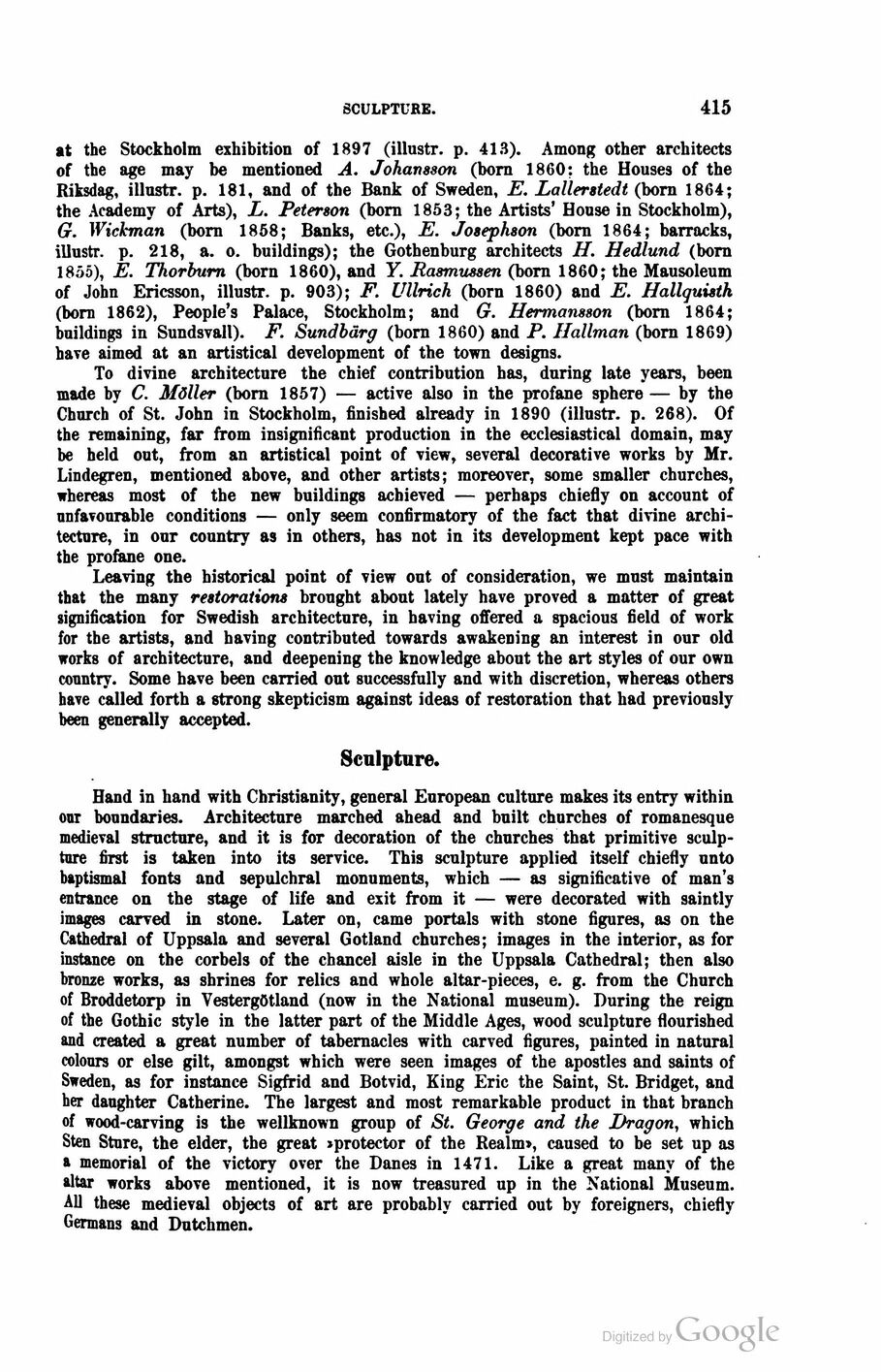
Full resolution (JPEG) - On this page / på denna sida - First part - IV. Education and Mental Culture - 9. The Fine Arts - Architecture, by F. Sundbärg, City Architect, Landskrona - Sculpture, by Prof. C. R. Nyblom, Ph. D., Stockholm

<< prev. page << föreg. sida << >> nästa sida >> next page >>
Below is the raw OCR text
from the above scanned image.
Do you see an error? Proofread the page now!
Här nedan syns maskintolkade texten från faksimilbilden ovan.
Ser du något fel? Korrekturläs sidan nu!
This page has never been proofread. / Denna sida har aldrig korrekturlästs.
SCULPTURE.
415
at the Stockholm exhibition of 1897 (illustr, p. 413). Among other architects
of the age may be mentioned A. Johansson (born I860: the Houses of the
Riksdag, illustr, p. 181, and of the Bank of Sweden, E. Lallerstedt (born 1864;
the Academy of Arts), L. Peterson (born 1853; the Artists’ House in Stockholm),
G. Wickman (born 1858; Banks, etc.), E. Josephson (born 1864; barracks,
illustr, p. 218, a. o. buildings); the Gothenburg architects H. Hedlund (born
1855), E. Thorburn (born 1860), and Y. Rasmussen (born 1860; the Mausoleum
of John Ericsson, illustr, p. 903); F. Ullrich (born 1860) and E. Hallguisth
(born 1862), People’s Palace, Stockholm; and G. Hermansson (born 1864;
buildings in Sundsvall). F. Sundbärg (born 1860) and P. Hallman (born 1869)
have aimed at an artistical development of the town designs.
To divine architecture the chief contribution has, during låte years, been
made by C. Möller (born 1857) — active also in the profane sphere — by the
Church of St. John in Stockholm, finished already in 1890 (illustr, p. 268). Of
the remaining, far from insignificant production in the ecclesiastical domain, may
be held out, from an artistical point of view, several decorative works by Mr.
Lindegren, mentioned above, and other artists; moreover, some smaller churches,
whereas most of the new buildings achieved — perhaps chiefly on account of
unfavourable conditions — only seem confirmatory of the fact that divine
architecture, in our country as in others, has not in its development kept pace with
the profane one.
Leaving the historical point of view out of consideration, we must maintain
that the many restorations brought about lately have proved a matter of great
signification for Swedish architecture, in having offered a spacious field of work
for the artists, and having contributed towards awakening an interest in our old
works of architecture, and deepening the knowledge about the art styles of our own
country. Some have been carried out successfully and with discretion, whereas others
have called forth a strong skepticism against ideas of restoration that had previously
been generally accepted.
Sculpture.
Hand in hand with Christianity, general European culture makes its entry within
our boundaries. Architecture marched ahead and built churches of romanesque
medieval structure, and it is for decoration of the churches that primitive
sculpture first is taken into its service. This sculpture applied itself chiefly unto
baptismal fonts and sepulchral monuments, which — as significative of man’s
entrance on the stage of life and exit from it — were decorated with saintly
images carved in stone. Later on, came portals with stone figures, as on the
Cathedral of Uppsala and several Gotland churches; images in the interior, as for
instance on the corbels of the chancel aisle in the Uppsala Cathedral; then also
bronze works, as shrines for relics and whole altar-pieces, e. g. from the Church
of Broddetorp in Vestergötland (now in the National museum). During the reign
of the Gothic style in the latter part of the Middle Ages, wood sculpture flourished
and created a great number of tabernacles with carved figures, painted in natural
colours or else gilt, amongst which were seen images of the apostles and saints of
Sweden, as for instance Sigfrid and Botvid, King Erie the Saint, St. Bridget, and
her daughter Catherine. The largest and most remarkable product in that branch
of wood-carving is the wellknown group of St. George and the Dragon, which
Sten Sture, the elder, the great »protector of the Realm», caused to be set up as
a memorial of the victory over the Danes in 1471. Like a great many of the
altar works above mentioned, it is now treasured up in the National Museum.
All these medieval objects of art are probably carried out by foreigners, chiefly
Germans and Dutchmen.
<< prev. page << föreg. sida << >> nästa sida >> next page >>